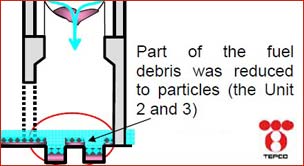
Report: Massive release of Fukushima radioactive waste being planned — Gov’t Official: I was overwhelmed by amount of contaminated water from reactors, we must dump it into ocean — Experts: Much of melted nuclear fuel is now particles which are inside the water (VIDEO)
ENE News
Asahi Shimbun, Dec 13, 2014 (emphasis added): NRA head signals massive release of tainted water to help decommission Fukushima site — The head of Japan’s nuclear watchdog said contaminated water stored at the crippled Fukushima No. 1 nuclear power plant should be released into the ocean… Shunichi Tanaka, the chairman of the Nuclear Regulation Authority, made the comment Dec. 12 after visiting the facility… “I was overwhelmed by the sheer number of tanks (holding water tainted with radioactive substances),” Tanaka told reporters, indicating they pose a danger to decommissioning work. “We have to dispose of the water… We also have to obtain the consent of local residents in carrying out the work, so we can somehow mitigate (the increase in tainted water)… While (the idea) may upset people, we must do our utmost to satisfy residents of Fukushima,” Tanaka said, adding that the NRA would provide information to local residents based on continuing studies of radioactive elements in local waters.
US Nuclear Regulatory Commission senior scientist Dana Powers, 2011: Should the accident progress so that molten core debris can penetrate the reactor vessel and molten core debris cascade into the drywell… the core debris interactions with the concrete will lead to the… release of droplets of core debris 1-5 micrometers in size that will contain the radionuclides at the bulk core debris concentration.
Tokyo Electric Power Company: MAAP analysis & Core concrete reaction – Part of the fuel debris was reduced to particles… [Unit 2 scenario] Ratio of particle: 62%… [Unit 3 scenario] Ratio of particle: 56%.
Radiation & Nuclear Safety Authority (Norway), University of Helsinki, 2003: Determination of Transuranic Elements, Their Behaviour and Sources in the Aquatic Environment — In comparatively shallow water bodies, usually more than 90 % of total Pu [plutonium] is rapidly transferred to sediments associated with particulate materials. In deep oceans… the situation is different: most Pu remains in the water phase for a long time due to a slow mixing of water masses and slow sedimentation rates… TRUs can be either soluble or fixed in particulate fraction… in the Baltic Sea, the proportion of soluble Pu varied from 25 to 70 % of total Pu in the water… The finest particles can be easily transported long distances.
Watch NHK video of Tanaka’s tour of Fukushima Daiichi here
Published: December 15th, 2014 at 11:58 am ETBy ENENews |

